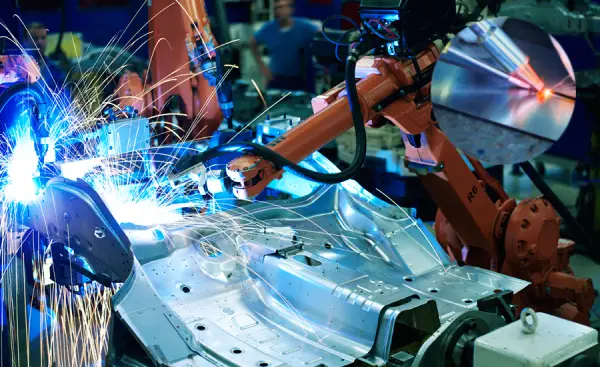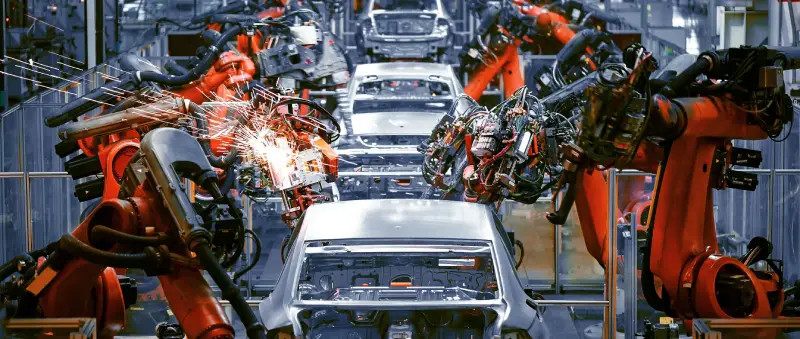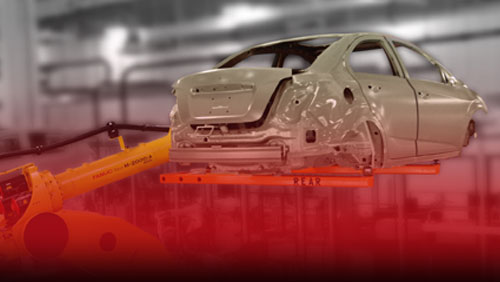Mega Machine’s robotic welding solutions are a game-changer for automotive manufacturing, helping companies boost efficiency, quality, and precision in their production processes. Here’s how their robotic systems improve automotive manufacturing:
Enhanced Precision and Consistency
- Robotic welding systems offer extreme precision and repeatability, which is essential for high-quality automotive manufacturing. These robots are programmed to perform welding tasks with the same exact measurements every time, eliminating human error and ensuring that welds are uniform and strong.
- This consistent precision ensures that the parts being welded meet the exact specifications required for safety and performance, especially in critical areas like chassis and structural components.

Increased Production Speed
- Robot systems can work continuously without fatigue, significantly increasing the speed of the welding process. In automotive manufacturing, where high-volume production is crucial, robots help achieve faster cycle times. This leads to quicker production rates while maintaining quality standards.
- The use of robotic welders reduces downtime and enhances overall throughput in the factory.
Reduced Welding Variability
- Variability in welding is one of the most significant challenges in automotive production. Even small inconsistencies in a weld can lead to product defects, delays, or costly rework.
- Mega Machine’s robotic welding systems utilize advanced sensors, cameras, and real-time feedback mechanisms that enable robots to adapt to slight changes in parts, maintaining perfect welds even when there is some variability in the materials or components being welded.
Cost Efficiency
- Although robotic systems can be a significant upfront investment, they pay for themselves over time by reducing labor costs and the cost of defects or rework. Once the robots are programmed, they can work for long shifts without needing additional personnel, reducing the overall labor requirements.
- Additionally, the consistency and precision of robotic welds reduce the risk of defects and the need for expensive repairs or replacements, which lowers overall production costs.

Flexibility and Scalability
- One of the key advantages of robotic welding is its adaptability. Robotic systems can be reprogrammed and adjusted to accommodate different car models or changing production requirements, making them an excellent investment for automakers who need flexibility.
- Robots can easily be scaled up or down, depending on the manufacturing needs, whether it’s a high-demand production run or a low-volume specialized component.
Optimized Welding Design
- With robots, manufacturers can take advantage of advanced welding techniques, like laser or friction stir welding, which can be difficult for human welders to perform consistently.
- These techniques can enhance the strength, durability, and overall quality of the weld, resulting in improved vehicle performance and safety.
Data and Performance Monitoring
- Mega Machine’s robotic welding solutions are often integrated with data analytics systems that track and monitor the performance of the robots in real time.
- This allows manufacturers to identify any potential issues early on and optimize the welding process, minimizing downtime and improving overall production efficiency.
Enhanced Quality Control
- The automation of welding processes enables the continuous inspection and monitoring of the welds in real-time. Robots equipped with advanced vision systems and sensors can detect defects such as porosity or undercuts, ensuring only top-quality parts are produced.
- Any issues that arise can be flagged immediately for correction, improving the overall product quality.
Improved Safety and Reduced Labor Risks
- Welding is a hazardous process due to the exposure to heat, sparks, and fumes. By using robotic welding systems, manufacturers reduce the need for human operators to be exposed to these dangers.
- Robots can perform dangerous welding tasks in high-risk environments, such as high-temperature zones, which keeps workers safe and minimizes the risk of accidents and injuries.

Conclusion:
Mega Machine’s Robotic Systems welding solutions optimize every phase of the automotive manufacturing process. From speed and precision to safety and cost-efficiency, robotic welding provides the automotive industry with a means to increase production capacity while maintaining the highest standards of quality. As automakers face increasing pressure to improve manufacturing processes, robotic welding represents a significant advancement in meeting these challenges.




